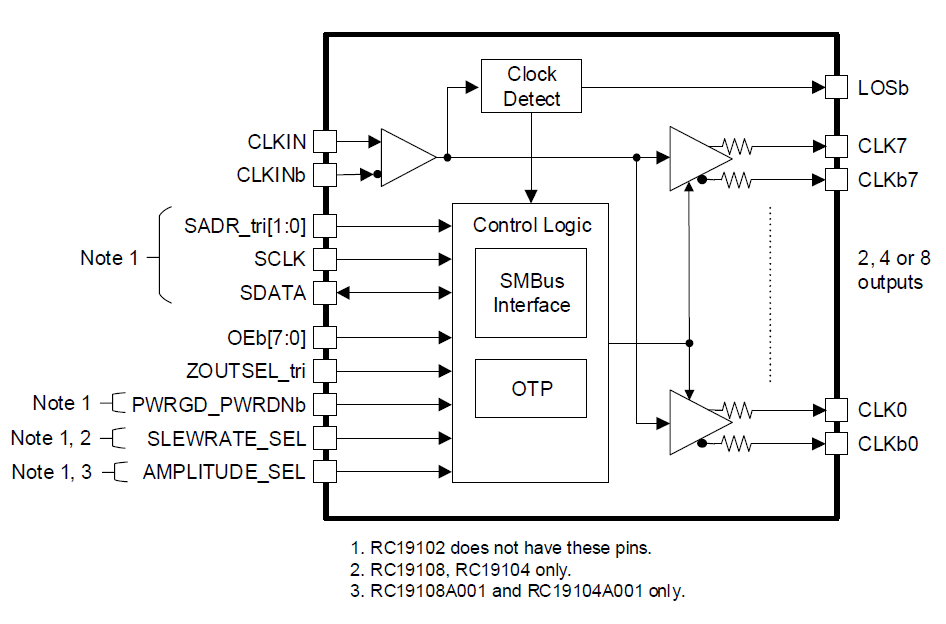特長
- PCIe Gen5 付加位相ジッター: 6fs RMS
- PCIe Gen6 付加位相ジッター: 4fs RMS
- PCIe Gen7 付加位相ジッター: 2.6fs RMS
- DB2000Q付加位相ジッタ:10fs RMS
- 12kHz〜20MHzの付加位相ジッタ:156.25MHzで33fs RMS
- Power Down Tolerant (PDT)入力
- Flexible Startup Sequencing (FSS)
- CLKIN 信号ロス時のAutomatic Clock Parking (ACP)
- スペクトラム拡散耐性
- CLKINはHCSLまたはLVDS信号レベルに対応しています
- -40 °C 〜 +105 °C、1.8V ± 5% 動作
- ピンまたはSMBusを選択可能:
- 33Ω、85Ω、または100Ωの差動出力インピーダンス
- 出力スルーレート
- 出力振幅 (A001 サフィックス)
- 9つのSMBusアドレスと書き込み保護
説明
RC19104は、以前のPCIe世代(Gen.1~6)と後方互換性がある1.8V 4出力のPCIe Gen7バッファです。 RC19104は、超低付加ジッターと入出力間遅延の低減により設計マージンを高め、より容易で堅牢な設計を実現するためのいくつかの機能を内蔵しています。
パラメータ
| 属性 | 値 |
|---|---|
| Temp. Range (°C) | -40 to 105°C |
パッケージオプション
| Pkg. Type | Pkg. Dimensions (mm) | Lead Count (#) | Pitch (mm) |
|---|---|---|---|
| VFQFPN | 4.0 x 4.0 x 0.9 | 28 | 0.4 |
製品比較
| RC19104A | RC19004 | 9ZXL0451E | 9DBL0452 | |
| Core Voltage (V) | 1.8 | 3.3 | 3.3 | 3.3 |
| Output Impedance | 34, 85, 100 | 85, 100 | 85 | 85 |
| App Jitter Compliance | PCIe Gen1, PCIe Gen2, PCIe Gen3, PCIe Gen4, PCIe Gen5, PCIe Gen6, PCIe Gen7 | PCIe Gen1, PCIe Gen2, PCIe Gen3, PCIe Gen4, PCIe Gen5, PCIe Gen6, PCIe Gen7 | 25G EDR, DB2000Q, IF-UPI, PCIe Gen1, PCIe Gen2, PCIe Gen3, PCIe Gen4, PCIe Gen5, QPI, UPI | PCIe Gen1, PCIe Gen2, PCIe Gen3, PCIe Gen4, PCIe Gen5, PCIe Gen6 |
| VOUT Slew-rate Control | Yes | Yes | No | No |
| Additive Jitter | 4fs | 4fs | - | 13fs |
| VOUT Amplitude Control | Yes | No | No | No |
アプリケーション
- クラウド/ハイパフォーマンスコンピューティング
- nVMEストレージ
- ネットワーク
- アクセラレータ
適用されたフィルター
フィルター
ソフトウェア/ツール
サンプルコード
シミュレーションモデル
The RC family consists of PCIe Gen7 clock buffer and multiplexer solutions, providing the industry's smallest and most compact footprint.
Introducing Renesas’ enhanced PCIe clock buffer family. These PCIe Gen5 clock buffers offer fanout and zero-delay operating modes, supporting both legacy systems and the most complex timing trees within a single device. Unlike many existing solutions, whose performance limitations force their use in fanout buffer mode, these clock buffers meet both PCIe Gen5 and prominent CPU-specific phase jitter requirements in all operating modes. The extremely low 50fs rms PCIe Gen5 additive phase jitter enables multi-level cascading within the strict PCIe Gen5 jitter budget. Renesas’ high-performance oscillators and clock generators provide an ideal clock source for the enhanced PCIe clock buffer family.
For more information about these PCIe Gen5 clock buffers, visit the PCIe timing page.
A detailed overview of IDT's full-featured PCI Express (PCIe) clock and timing solutions. The presentation addresses PCIe Gen 1, Gen 2, Gen 3, and Gen 4 architectures and how IDT's industry-leading solutions provide all the functions, features, and performance required by the application.
Presented by Ron Wade, System Architect at IDT. For more information visit the PCIe clocks page.
The 9ZXL1951D is designed to create clocks for PCI Express Generation 4. This video demonstrates how the reference clock for the 9ZXL1951D does not need to be PCI Express Gen4 compliant. When using the Low Bandwidth mode, the 9ZXL1951D will attenuate jitter so its output clocks still pass PCI Express Gen4, even when the input clock only passes PCI Express Gen3. This is most useful when the clock has spread spectrum modulation because it is very difficult to make a very low noise spreading clock.
Related Resources
A brief overview of how data rates have changed from PCI Express (PCIe) Generation 1, Gen 2, Gen 3, Gen 4 and Gen 5.
Presented by Ron Wade, system architect at IDT. For more information about IDT's PCIe timing solutions, visit the PCI Express (PCIe) Clocks page.
A brief overview of how clock and timing specifications have changed from PCI Express (PCIe) Generation 1, Gen 2, Gen 3, Gen 4 and Gen 5.
Presented by Ron Wade, system architect at IDT (acquired by Renesas). For more information, visit Renesas's PCIe Timing Solutions page.
A brief overview of the PCI Express common clock (CC) jitter model, and the transfer functions as they relate to the timing PLLs. This model applies to PCI Express (PCIe) Gen 2, Gen 3, Gen 4 and Gen 5. The equations would be slightly different for other PCIe architectures, such as SRIS, SRnS, or data clocked.
Presented by Ron Wade, system architect at IDT (acquired by Renesas). For more information about Renesas's PCIe timing solutions, visit the PCI Express (PCIe) Clocks page.
This video compares PCIe Gen3–7 common clock jitter filters with a typical 12kHz to 20MHz plot to highlight the differences in filtering approaches.

